How To Install Tomcat On Windows
Introduction
Apache Tomcat is an open-source web server and servlet container for Java lawmaking. Tomcat executes programs written in the Java programming language, and it implements many Coffee EE specifications, including Jakarta Servlet, Djakarta Server Pages, and others.
In this tutorial, you lot volition acquire to install the Apache Tomcat server on Windows.
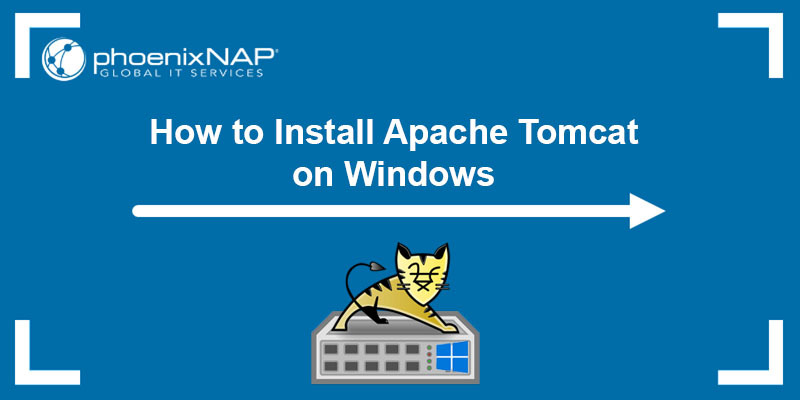
Prerequisites:
- Java JRE installed and configured
- Ambassador privileges
How to Install Tomcat on Windows
In this section, we will cover two means of installing the Tomcat web server:
- Via Windows Service Installer.
- From a zip annal.
Follow the steps below to download and install Tomcat.
Step ane: Download Tomcat for Windows
To download the Tomcat installation file, follow the steps below:
1. Browse to the official Apache Tomcat website. Locate the Download section and click the latest Tomcat version bachelor. At the time of writing this article, the latest Tomcat version was version ten.
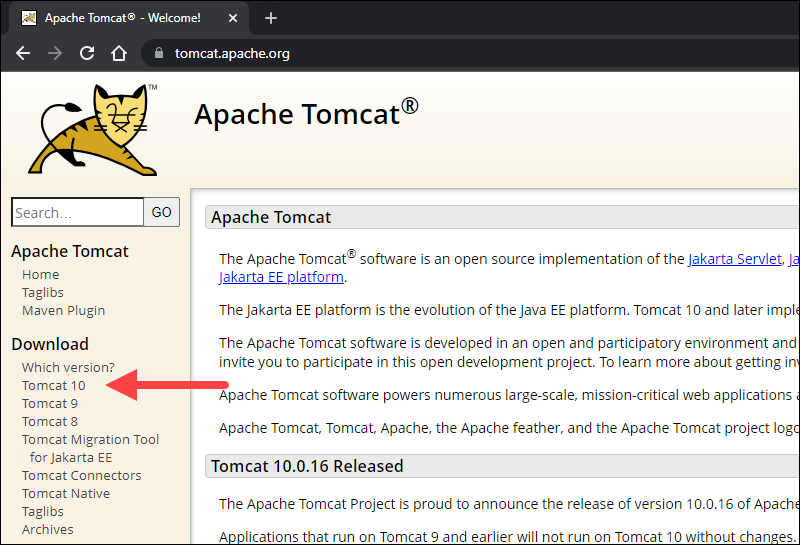
2. On the Download page, scroll down and locate the Binary Distributions area.
In the Cadre list, depending on the installation type you adopt, click the download link for the Windows Service Installer or the 32bit/64bit Windows nix file.

Step ii: Install Tomcat
Install Tomcat via the Windows Service Installer for an automatic and wizard-guided experience. The service installer installs the Tomcat service and runs it automatically when the system boots.
For a portable feel, install Tomcat using the zip file and avoid installing the service. Easily uninstall Tomcat when it is no longer needed by deleting the Tomcat directory, or move it effectually when necessary.
Notation: Have a look at our list of 13 best Java IDEs, which assistance write, debug, and test Java code.
Method ane: Install Tomcat Using the Windows Service Installer
Follow the steps below to install Tomcat using the Windows Service Installer.
1. Open the downloaded Windows Service Installer file to start the installation process.
2. In the Tomcat Setup welcome screen, click Next to continue.

three. Read the License Agreement and if you agree to the terms, click I Agree to proceed to the next pace.
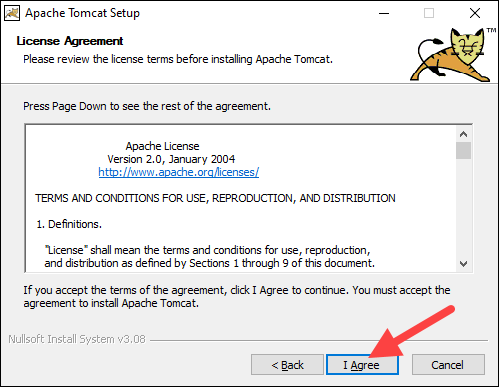
4. In the Tomcat component selection screen, choose Full in the dropdown menu to ensure the magician installs the Tomcat Host Manager and Servlet and JSP examples web applications. Alternatively, proceed the default Normal installation type and click Next.
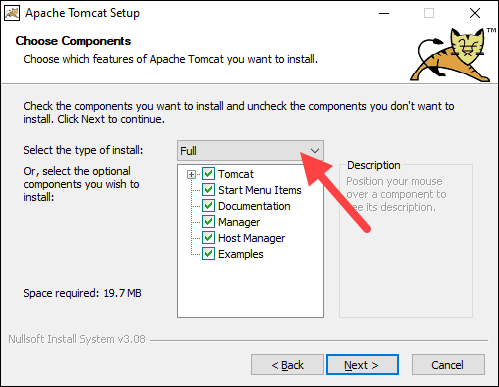
v. The next pace configures the Tomcat server. For case, enter the Ambassador login credentials or choose a different connectedness port. When finished, click Adjacent to proceed to the adjacent step.
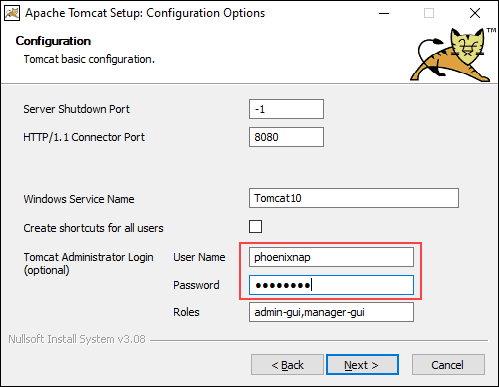
6. The next step requires you to enter the total path to the JRE directory on your system. The wizard auto-completes this if you have previously prepare up the Coffee environment variables. Click Next to proceed to the side by side step.
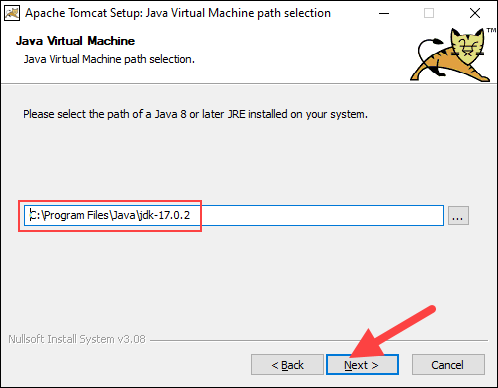
7. Choose the Tomcat server install location or keep the default ane and click Install.

8. Check the Run Apache Tomcat box to start the service after the installation finishes. Optionally, check the Prove Readme box to see the Readme file. To complete the installation, click Finish.
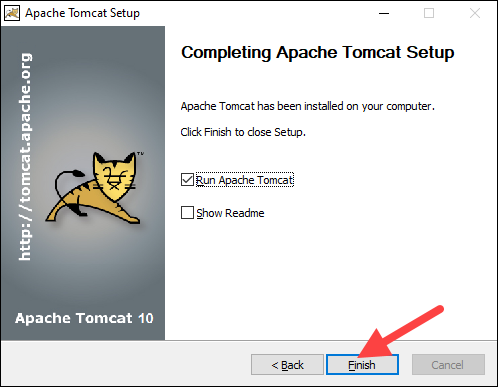
9. A popup window appears that starts the Tomcat service. After the procedure completes, the window closes automatically. The Apache Tomcat spider web server is at present successfully installed .
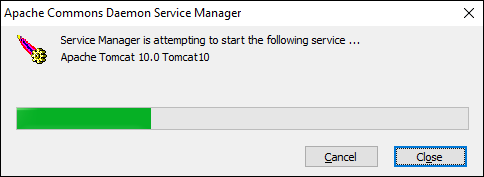
Method 2: Install Tomcat Using the aught Archive
Follow the steps beneath to set up the Tomcat server using the zip archive.
1. Later downloading the 32bit/64bit Windows zip file, depending on your Windows version, unzip the downloaded file. Correct-click the file and select Extract all...
two. Choose where to extract the archive contents. For easier navigation, we recommend extracting information technology to the hard drive's root. Optionally, give the directory a shorter proper noun to facilitate server configuration afterward. Click Extract to get-go the process.
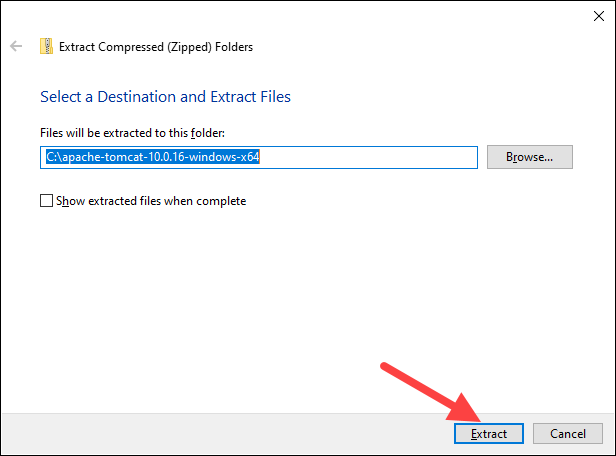
3. Navigate to the conf sub-directory within the extracted directory and locate the server.xml file.
Important: Dorsum up the .xml files before making any changes.
4. The default connection port is 8080 . To choose a different port, edit the server.xml file with a text editor, such as Notepad++, and locate the following lines:
<Connector port="8080" protocol="HTTP/1.1" connectionTimeout="20000" redirectPort="8443" /> Modify the connector port number to whatsoever number betwixt 1024 and 65535 .
v. To enable directory browsing, locate the web.xml file in the conf directory and edit the file with a text editor. Directory browsing helps when testing the organization, and sometimes it may be the solution for a 403 forbidden error.
Locate the following lines and change the listings value from false to true :
<servlet> <servlet-proper noun>default</servlet-name> <servlet-class>org.apache.catalina.servlets.DefaultServlet</servlet-form> <init-param> <param-proper name>debug</param-proper noun> <param-value>0</param-value> </init-param> <init-param> <param-proper name>listings</param-name> <param-value>false</param-value> </init-param> <load-on-startup>one</load-on-startup> </servlet> six. Implement an machine-reload feature past editing the context.xml file. Above all, auto-reload is useful in development to prevent restarting the server manually each time a change is made.
Using a text editor, open the context.xml file. Locate the following line and change the value from false to true in each case:
<Context reloadable="fake" crossContext="false" parallelAnnotationScanning="simulated"> ...... ...... </Context> seven. Later on making the changes, starting time the server. Printing the Windows key and type cmd. Printing Enter to open a Command Prompt window.
8. Move to the bin directory of your Tomcat server and run:
startup 
viii. Add an exception for Tomcat in the firewall:
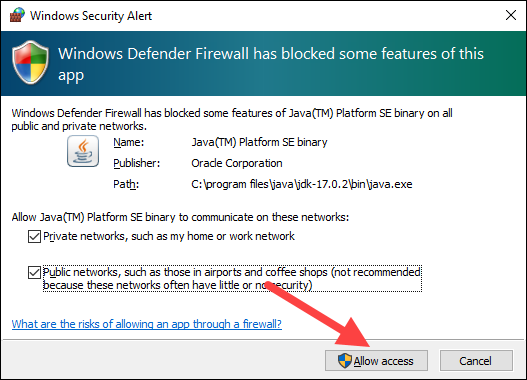
9. A new Tomcat console window appears. This console receives error messages and system.out.println() messages issued by the Java servlets.
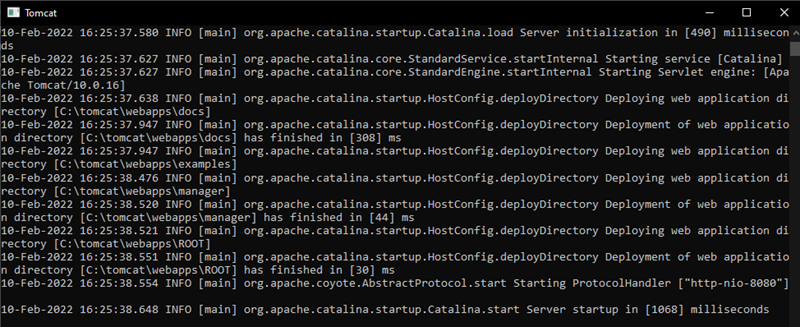
10. Admission the server using a browser as an HTTP client. Browse to http://localhost:8080 and access the Tomcat welcome page to ensure the server works.
In improver, utilize the Developer Quick Start links to see more information most the server and start using and configuring the server.
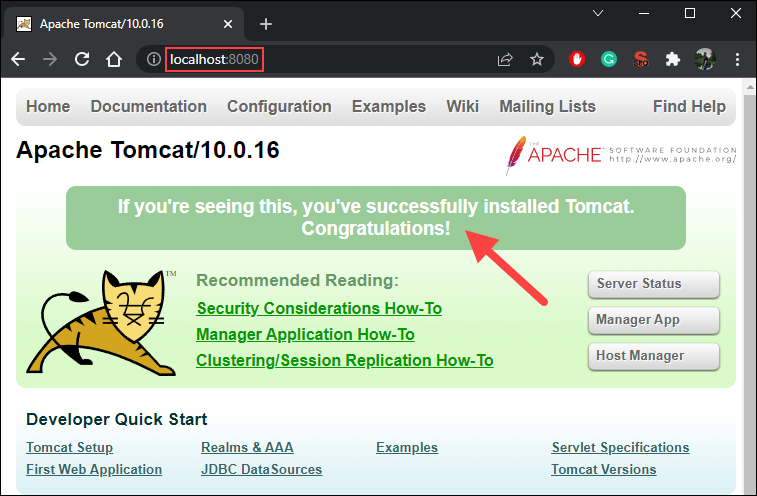
11. Close downward the Tomcat server by pressing Ctrl+C on the Tomcat console.
Pace 3: Cheque if Apache Tomcat Service Is Running
Installing Tomcat using the Windows Service Installer installs Tomcat every bit a Windows service that automatically runs on kicking. Follow the steps beneath to ensure that Tomcat is started equally a Windows service.
1. Open the Start carte du jour and search for Services.
2. Select the Services result.

3. In the Services window, locate the Apache Tomcat service. The Status column indicates whether the service is running or not. Kickoff or Stop the service using the buttons in the toolbar or by pressing Terminate or Restart on the left side of the service listing.
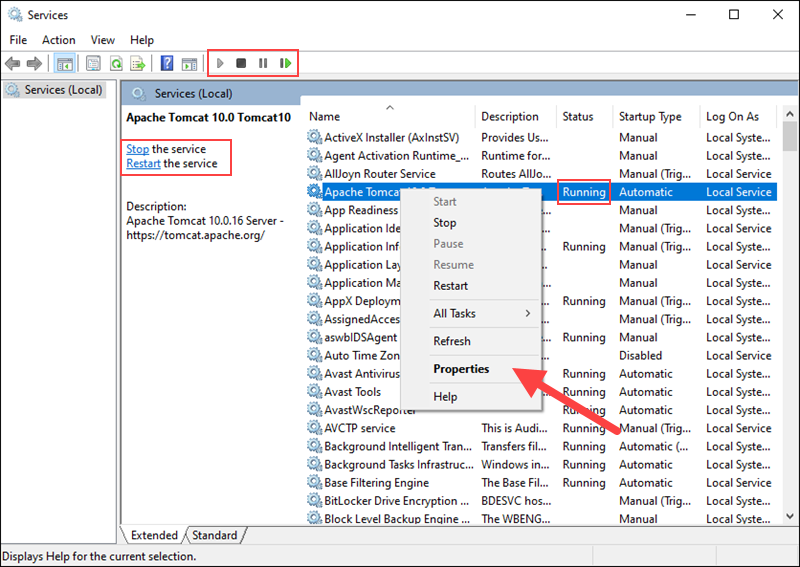
Configure the service startup by right-clicking the Tomcat service and selecting Properties.
4. In the Properties window, under the Startup type dropdown card, select how to run the Tomcat service:
- Automatic (Delayed Start). Starts the service shortly after boot. A delayed start improves server boot performance and has security benefits.
- Automated. Automatically starts the service on boot.
- Transmission. The service starts only when Windows or another service needs it or if invoked.
- Disabled. Disables the service startup, even if you endeavour to start information technology.

Click OK to confirm the changes.
Decision
This guide showed how to install the Apache Tomcat web server on Windows. While Tomcat doesn't provide all the features of Coffee EE, many applications require only the features that Tomcat provides. Therefore, heavier tools aren't always necessary.
Larn more most servers in our tutorial on big data servers, or learn what a database server is.
Was this article helpful?
Aye No
How To Install Tomcat On Windows,
Source: https://phoenixnap.com/kb/install-tomcat-windows
Posted by: berrynough1996.blogspot.com


0 Response to "How To Install Tomcat On Windows"
Post a Comment